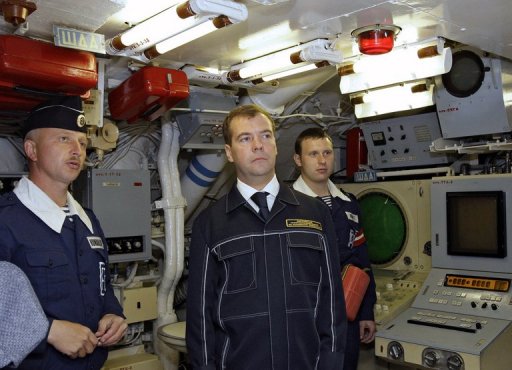
Bulava Launch Failure and the Crisis of Russian Defense Industry
Publication: Eurasia Daily Monitor Volume: 6 Issue: 233
By:

The recent Bulava launch failure has implications for US-Russian arms control talks (EDM, December 17) and will determine whether the Russian defense industry is capable of delivering advanced weapons systems at qualitative levels competing with analogous systems produced abroad. The issue involves the quality of such systems, their relative costs, and the time for their research, development and deployment. This year the Russian defense ministry has selectively answered that question negatively and has bought advanced unmanned aerial vehicles (UAV) from Israel and entered into discussions with France over the purchase of a Mistral-class amphibious assault ship, which so far has not resulted in a contract.
Objections to foreign purchases naturally come from the affected sector of the defense industry and from defense intellectuals, who warn about the risks of relying on foreign purchases when changes in the international situation might mean terminations of contracts or denial of required spare parts. In an article devoted to the draft military doctrine expected to be published soon, unnamed sources said the text stipulates that foreign purchases will be restricted to areas where the Russian defense industry cannot deliver quality products. Commenting on the leak, the Deputy Chairman of the Defense Committee of the Duma, Yury Savenko, said that the General Staff supported the policy, but noted that defense contractors sat on state orders. He said that the challenge was to deliver quality products with which the armed forces could fight (www.gazeta.ru, December 17).
In the case of strategic missile systems there is, of course, no possibility of foreign purchases, given the limited number of producers and the strategic sensitivity of the systems. Therefore, the crisis with the solid-fueled submarine launched ballistic missile (SLBM) Bulava (R-30 3M30 – NATO SS-NX-30) has deep strategic ramifications for Russia’s sea-based nuclear strike forces. Bulava was planned as the chief maritime nuclear weapon on board the new class of SSBN’s (Project 955 Borei, the first of which, the Yuriy Dolgorukiy, is undergoing sea trials. Two others are under construction and a fourth was due to begin construction at Severodvinsk shortly). The shipyard announced that the navy had suspended the initiation of that project. Further tests of the Bulava were postponed until March 2010. Given the importance of that force to Russia’s national security, the current crisis with the Bulava questions the ability of the Russian defense industry to deliver high-quality weapons in a cost-effective and timely matter. In the absence of operational SLBM’s, this class of warship has no military-strategic value, and the money spent on the missile’s development and the submarines’ construction becomes a net loss.
In preparation for the most recent and delayed test, every signal was about anticipated success. The problems that caused past failures (eleven out of twelve launches) had been analyzed and solutions found (RIA Novosti, November 24). When the test occurred on December 9, the missile exploded shortly after launch, leading to speculation in northern Norway about a UFO. In fact, the missile’s failure became a case of friendly fire, doing serious damage to the navy, Russia’s strategic forces and defense industry (Nezavisimaya Gazeta, December 10).
The Bulava has become a hot topic for discussion within defense industry circles. Experts involved in the development of the Bulava have come forward to chronicle the mistakes that were made in its development. The initial decision made economic and technical sense: developing a single base type ICBM for both ground and sea launch. Topol-M, the solid-fuel prototype for Russia’s future land-based ICBM force would also provide the basic design for the SLBM. Technical experts in the development of past sea-based systems warned about the very different stress that a submerged-launched missile had to withstand. However, ten years ago with limited funds and cozy relations among politicians, senior military leaders, and some defense contractors, it resulted in a decision presented as securing a quality product at reduced costs. Production of the R-39, which was deployed on the Typhoon-class SSBN’s, was curtailed and the follow-on development of a modernized version was canceled after three unsuccessful launches, leaving the navy with no other SLBM under development. Thereafter, the defense ministry withdrew the Typhoon-class SSBN’s from service, retaining only one, the Dmitry Donskoy, modified to serve as a test-launch platform for Bulava (Nezvasimoe Voennoe Obozrenie, December 11).
The Moscow Institute of Thermal Technology defense contractor promised the speedy development of both land and sea-based systems, while lacking any experience in the research and development of sea-based missiles. The chief designer for MITT, Yury Solomonov, promised to cut costs by combining the development of solid-fueled, land and sea-based ICBM’s around one prototype, Topol-M: eliminating of the risks associated with liquid-fueled missiles at sea, and providing the navy with a missile and platform equivalent to the first-generation Trident-class SLBM’s. In the aftermath of the failed twelfth test-launch, critics made their objections public. Albert Dubrovin and Sergei Makeev, men with impressive defense industry credentials called Bulava “the non-combat ready missile, which has already destroyed the submarine navy and a series of scientific-research institutes.” The authors detailed the decision to develop Bulava, the fate of other naval missile projects, and the critical flaws in the development of Bulava, which has left the navy without the key weapons system for a vital part of the strategic deterrent force. MITT designed a soft submerged launch technique (container), untested in sea conditions, which put entirely different tensions upon the missile during launch. They view the future prospects for Bulava very critically. Even if successful, it will be an inferior system with huge cost-overruns, and a very slow delivery rate. The authors estimate that at current rates of production for Topol-M and Iskander missiles, it will take twenty years to produce all the missiles needed to arm the eight planned Project 955 Borei class submarines (Nezvasimoe Voennoe Obozrenie, December 11).
The latest launch failure of Bulava reflects badly on the capacity of the Russian defense industry to produce quality weapons systems in a timely fashion at competitive costs. A decade lost on a key strategic system represents a profound failure, which the new military doctrine will have to address if it is to be taken seriously by the Russian military, the nation, and the rest of the world. In weapons development, as in warfare, the greatest loss from which it is almost impossible to recover is time.




